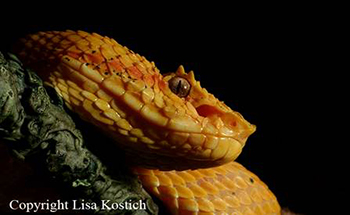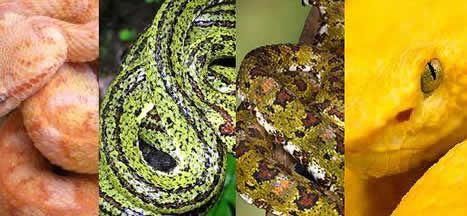Eyelash Viper
Bothreichis schlegelii

Taxonomy
Order: Squamata
Sub-Order: Serpentes
Family: Viperidae
Sub-Family: Crotalinae
Fast Facts
Animal Type: Venomous Pit Viper
Venom Delivery: Solenoglyphous
Venom Type: Hemotoxic
Primary Diet: Carnivorous; Rodents, Frogs, Lizards, Birds
Average Size: 56 to 81 centimeters (22-32 in)
Size at Birth: 15-18 cm (6-7 in)
Altitude Range: 0-2640 me

Range of Bothriechis schlegelii
Range / Habitat
B. schlegelii is an arboreal pit viper found in low altitude, humid areas, usually near a permanent water source (“Bothriechis schlegelii,”). They are found extensively throughout tropical areas of Central America with preference for tropical forests with dense vegetation. They can be found as far north as southern Mexico and as far south as Ecuador and Peru.

Coloration Variation in Bothriechis schlegelii
Morphology and Coloration
B. schlegelii is a small pit viper with a triangular-shaped head. Its scales are rough and keeled, an adaptation to defend against rough foliage. Several scales above the eye are modified and extended, resembling the eyelashes for which the species gets its common name. The modified scales are most likely an adaptation to provide camouflage, useful for this ambush predator. Another adaptation of B. schlegelii is its strongly prehensile tail, which it uses to adeptly move about in its primarily arboreal habitat.
B. schlegelii has sensory structures unique to the Bothriechis genus. They have very sensitive infra red detecting organs that provide information on both distance and direction of prey (Parker). The pit organs are paired and provide the organism with “thermal rangefinder capabilities”(Bullock). These unique organs allow the animal to efficiently attack prey, even if deprived of the senses of sight and smell.
Coloration in B. schlegelii varies greatly and depends on geographical location. They can be relatively solid or highly figured in any combination of pinks, yellows, greens, or browns (see image above).
Behaviors
B. schlegelii is often found in trees or shrubs near water. It is an ambush predator, generally waiting in one place for a possible meal to pass by, then striking. Juvenile individuals are known to employ caudal luring, wiggling the tail to attract potential prey (Heatwole). They are not usually aggressive but will not hesitate to strike if threatened.
Predation
Predatory threats to B. schlegelii include many large mammals, larger snakes and some fish.
Reproduction
B. schlegelii is ovoviviparous, meaning that the eggs remain in the female until the juveniles are fully developed. They may exit the mother's body shortly before or shortly after hatching from their membranous eggs. Average clutch size for this species is six to 12, with a maximum around 20.
Sense of smell is an important aspect of mate selection in vipers. When courting females, males compete in a ritual called “the dance of the adders.” They face each other with the front of their bodies erect and attempt to knock each other down. No biting occurs. The ritual can go on for hours before a victor is determined (Smithsonian).
Conservation
As of 2002, B. schlegelii is no longer listed as a threatened species.
Interesting Facts
- They are one of the smallest venomous species in Central America.
- Individuals with the common yellow coloration are sometimes mistakenly shipped with bananas.
- Vipers have some of the longest fangs of any other snake family.
- Despite their toxic venom, they are popular pets because of their unusual appearance.
References
Please note that the following references may have either been removed or relocated by the webpage owners since the time this student report was created.
"Bothriechis schlegelii.” Wikipedia, The Free Encyclopedia. Wikimedia Foundation, Inc. 27 May 2012. Web. 21 Apr. 2012.
Bullock, T. H. and Diecke, F. P. J. (1956). Properties of an infrared receptor. Journal of Physiology 134, 47-87.
Eyelash Viper Fact Sheet. 2012. Smithsonian National Zoological Park. 27 May 2012 <http://nationalzoo.si.edu/animals/reptilesamphibians/facts/factsheets/Eyelashpalmpit
viper.cfm>.
Heatwole, H. and Davison, E. (1976). A Review of Caudal Luring in Snakes with Notes on Its Occurrence in the Saharan Sand Viper, Cerastes vipera. Herpetologica Vol. 32, No. 3, pp. 332-336.
Parker HW, Grandison AGC. 1977. Snakes – a natural history. Second Edition. British Museum (Natural History) and Cornell University Press. 108 pp. 16 plates. LCCCN 76-54625.